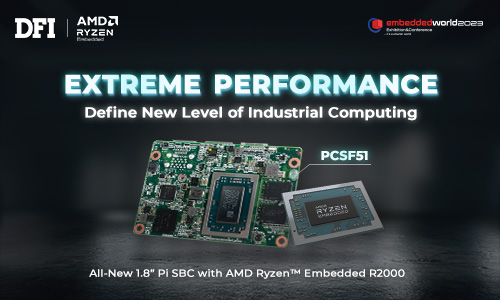DFI's First Half Profits Exceed Last Year, Expects Steady Growth with a Focus on Smart Healthcare, Factory, and Urban Rail Transit
DFI, the world's leading brand in embedded motherboards and industrial computers, had higher profits in the first half of this year compared to last year with an earnings per share (EPS) of $NT1.95 despite challenges of global inflation and increased interest rates. DFI held an investor conference today, and Vice Chairman Michael Lee said, “Although there are still many short-term uncertainties that need to be dealt with cautiously, client inventory adjustments have gradually ended, and businesses in machine tools and network security equipment have also gradually recovered. With enhanced planning for the three major application fields of smart factories, smart healthcare, and urban rail transits, as well as Edge AI and other forward-looking technologies, DFI expects beneficial results and is optimistic about medium and long-term performance.”
DFI’s second quarter consolidated revenue of this year was $NT3.761 billion, which was a quarterly decrease of 2% and annual decrease of 3%; the net income after-tax attributed to the parent company was $NT98 million with a quarterly decrease of 22% and annual decrease of 15%; EPS $NT0.85. The cumulative consolidated revenue for the first half of the year was $NT7.581 billion, which was an annual decrease of 2%; the net income after-tax attributed to the parent company was $NT223 million, which was an annual increase of 12%; EPS $NT1.95. Gross profit margin for the first half-year was 21% with an operating profit margin of 4.3%, and net income margin after-tax attributed to the parent company was 2.9%, which were each better than the same period last year.
Looking at the conditions of various markets in the first half of the year, Michael Lee pointed out that the growth momentum mainly came from Japan and Southeast Asia, while Europe and the United States were relatively stable. Therefore, even though China’s economic recovery did not meet expectations and demand was weak, DFI still produced profits and performed well. The increase in the “three margins” is attributed to strategies such as investing in smart factories and continuously increasing the proportion of high value-added products. It’s worth mentioning that through active destocking and procurement control in the past few quarters, the inventory levels of the company and clients have significantly decreased compared to last year and gotten back on the right track. The negative effects that were caused by lack of materials have now gradually dissipated.
Regarding the second half of the year, Michael Lee said that both machine tools and network security equipment will see a recovery in demand, and the industrial computer industry has the potential to recover by the fourth quarter at the quickest. There will also be new cases in the future, so he is optimistic about the overall performance and will work hard to adjust the structure in order to minimize possible negative effects. Looking forward, in addition to the inelastic demands of factory automation and other applications, he is optimistic about the continued vitality of the market driven by policies such as new infrastructure in Europe and the United States. By advancing in multiple ways and focusing on the three major markets of smart healthcare, smart factories, and urban rail transits, DFI can strengthen the development of forward-looking technologies such as Edge AI and put all of their efforts in increasing gross profit and the added value of products. Simultaneously, they will continue investing in smart factories to optimize manufacturing costs and improve the stability of operations.
Additionally, DFI will participate this year for the first time in the largest international automation exhibition in Southeast Asia and South Asia: India’s Automation Expo 2023. With smart factories as their key focus, they have planned four themed exhibition areas to display industrial automation related solutions such as SR-IOV virtualization technology and AGV/AMR robotics. Various products including industrial-grade motherboards, systems, and touch screen tablets will also have new product launch plans in the second half of the year.








,有助於車隊管理員管理駕駛行為、運動感測、急煞車和衝擊偵測.jpg?timestamp=1689918406.42007)




